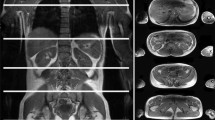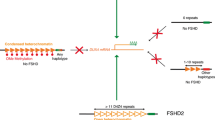Abstract
Objectives
Facioscapulohumeral muscular dystrophy (FSHD) is characterized by extremely variable degrees of facial, scapular and lower limb muscle involvement. Clinical and genetic determination can be difficult, as molecular analysis is not always definitive, and other similar muscle disorders may have overlapping clinical manifestations.
Methods and Materials
Whole-body muscle MRI examination for fat infiltration, atrophy and oedema was performed to identify specific patterns of muscle involvement in FSHD patients (30 subjects), and compared to a group of control patients (23) affected by other myopathies (NFSHD).
Results
In FSHD patients, we detected a specific pattern of muscle fatty replacement and atrophy, particularly in upper girdle muscles. The most frequently affected muscles, including paucisymptomatic and severely affected FSHD patients, were trapezius, teres major and serratus anterior. Moreover, asymmetric muscle involvement was significantly higher in FSHD as compared to NFSHD patients.
Conclusions
In conclusion, muscle MRI is very sensitive for identifying a specific pattern of involvement in FSHD patients and in detecting selective muscle involvement of non-clinically testable muscles. Muscle MRI constitutes a reliable tool for differentiating FSHD from other muscular dystrophies to direct diagnostic molecular analysis, as well as to investigate FSHD natural history and follow-up of the disease.
Key Points
• Muscle MRI identifies a specific pattern of muscle involvement in FSHD patients.
• Muscle MRI may predict FSHD in asymptomatic and severely affected patients.
• Muscle MRI of upper girdle better predicts FSHD.
• Muscle MRI may differentiate FSHD from other forms of muscular dystrophy.
• Muscle MRI may show the involvement of non-clinical testable muscles.







Similar content being viewed by others
Abbreviations
- BMD:
-
Becker muscular dystrophy
- DM1:
-
Myotonic dystrophy type 1
- FOV:
-
Field of view
- FSHD:
-
Facioscapulohumeral muscular dystrophy
- LGMD:
-
Limb-girdle muscular dystrophy
- MRI:
-
Magnetic resonance imaging
- NFSHD:
-
Non-facioscapulohumeral muscular dystrophy
- SNR:
-
Signal-to-noise ratio
- ADD:
-
Adductors
- BIC:
-
Biceps
- DEL:
-
Deltoid
- EXDL:
-
Extensor digitorum longus
- TFL:
-
Tensor Fascia Lata
- GASM:
-
Gastrocnemius medial
- GASL:
-
Gastrocnemius lateral
- GME:
-
Gluteus medium
- GMI:
-
Gluteus minimus
- GMX:
-
Gluteus maximus
- GR:
-
Gracilis
- ILI:
-
Iliacus
- INFR:
-
Infraspinatus
- LEVS:
-
Levator scapulae
- MUL:
-
Multifidus
- OBI:
-
Obturator internus muscle
- OBL:
-
Obliquus abdomini
- PEC:
-
Pectineus
- PER:
-
Peroneal
- PIR:
-
Piriformis
- PMI:
-
Pectoralis minor
- PMJ:
-
Pectoralis major
- PSO:
-
Psoas
- QUAF:
-
Quadratus femoris
- RAB:
-
Rectus abdominis
- RFEM:
-
Rectus femoris
- RHO:
-
Rhomboid
- SAR:
-
Sartorius
- SCAL:
-
Scalenus muscle
- SEM:
-
Semispinalis
- SER:
-
Serratus anterior
- SMB:
-
Semimembranous
- SMT:
-
Semitendinous
- SOL:
-
Soleus
- SPLC:
-
Splenius capitis
- SUBS:
-
Subscapularis
- SUPR:
-
Supraspinatus
- TA:
-
Tibialis anterior
- TM:
-
Teres major
- TP:
-
Tibialis posterior
- TRA:
-
Transversus abdominis
- TRP:
-
Trapezius
- VLA:
-
Vastus lateralis
- VME:
-
Vastus medialis
- VIN:
-
Vastus intermedius
References
Deenen JC, Arnts H, van der Maarel SM, Padberg GW, Verschuuren JJ, Bakker E, Weinreich SS, Verbeek AL, van Engelen BG (2014) Population-based incidence and prevalence of facioscapulohumeral dystrophy. Neurology 83(12):1056–1059
Padberg GW, Lunt PW, Koch M, Fardeau M (1991) Diagnostic criteria for facioscapulohumeral muscular dystrophy. Neuromuscul Disord 1(4):231–234
Flanigan KM (2004) Facioscapulohumeral muscular dystrophy and scapuloperoneal disorders, Myology, 2nd edn. McGraw-Hill, New York
Wijmenga C, Hewitt JE, Sandkuijl LA, Clark LN, Wright TJ, Dauwerse HG, Gruter AM, Hofker MH, Moerer P, Williamson R et al (1992) Chromosome 4q DNA rearrangements associated with facioscapulohumeral muscular dystrophy. Nat Genet 2(1):26–30
Cabianca DS, Casa V, Bodega B, Xynos A, Ginelli E, Tanaka Y, Gabellini D (2012) A long ncRNA links copy number variation to a polycomb/trithorax epigenetic switch in FSHD muscular dystrophy. Cell 149(4):819–831
Chan WP, Liu GC (2002) MR imaging of primary skeletal muscle diseases in children. AJR Am J Roentgenol 179(4):989–997
Mercuri E, Clements E, Offiah A, Pichiecchio A, Vasco G, Bianco F, Berardinelli A, Manzur A, Pane M, Messina S, Gualandi F, Ricci E, Rutherford M, Muntoni F (2010) Muscle magnetic resonance imaging involvement in muscular dystrophies with rigidity of the spine. Ann Neurol 67(2):201–208
Fischer D, Herasse M, Bitoun M, Barragan-Campos HM, Chiras J, Laforet P, Fardeau M, Eymard B, Guicheney P, Romero NB (2006) Characterization of the muscle involvement in dynamin 2-related centronuclear myopathy. Brain 129(Pt 6):1463–1469
Fischer D, Kley RA, Strach K, Meyer C, Sommer T, Eger K, Rolfs A, Meyer W, Pou A, Pradas J, Heyer CM, Grossmann A, Huebner A, Kress W, Reimann J, Schroder R, Eymard B, Fardeau M, Udd B, Goldfarb L, Vorgerd M, Olive M (2008) Distinct muscle imaging patterns in myofibrillar myopathies. Neurology 71(10):758–765
Stramare R, Beltrame V, Dal Borgo R, Gallimberti L, Frigo AC, Pegoraro E, Angelini C, Rubaltelli L, Feltrin GP (2010) MRI in the assessment of muscular pathology: a comparison between limb-girdle muscular dystrophies, hyaline body myopathies and myotonic dystrophies. Radiol Med 115(4):585–599
Olsen DB, Gideon P, Jeppesen TD, Vissing J (2006) Leg muscle involvement in facioscapulohumeral muscular dystrophy assessed by MRI. J Neurol 253(11):1437–1441
Kan HE, Scheenen TW, Wohlgemuth M, Klomp DW, van Loosbroek-Wagenmans I, Padberg GW, Heerschap A (2009) Quantitative MR imaging of individual muscle involvement in facioscapulohumeral muscular dystrophy. Neuromuscul Disord 19(5):357–362
Friedman SD, Poliachik SL, Carter GT, Budech CB, Bird TD, Shaw DW (2012) The magnetic resonance imaging spectrum of facioscapulohumeral muscular dystrophy. Muscle Nerve 45(4):500–506
Tasca G, Monforte M, Iannaccone E, Laschena F, Ottaviani P, Leoncini E, Boccia S, Galluzzi G, Pelliccioni M, Masciullo M, Frusciante R, Mercuri E, Ricci E (2014) Upper girdle imaging in facioscapulohumeral muscular dystrophy. PLoS One 9(6), e100292. doi:10.1371/journal.pone.0100292
Upadhyaya M, Cooper DN (2002) Molecular diagnosis of facioscapulohumeral muscular dystrophy. Expert Rev Mol Diagn 2(2):160–171
Gerevini S, Mandelli C, Cadioli M, Scotti G (2008) Diagnostic value and surgical implications of the magnetic resonance imaging in the management of adult patients with brachial plexus pathologies. SurgRadiol Anat 30(2):91–101. doi:10.1007/s00276-007-0292-3
Poliachik SL, Friedman SD, Carter GT, Parnell SE, Shaw DW (2012) Skeletal muscle edema in muscular dystrophy: clinical and diagnostic implications. Phys Med Rehabil Clin N Am 23(1):107–122, xi
Lamminen AE (1990) Magnetic resonance imaging of primary skeletal muscle diseases: patterns of distribution and severity of involvement. Br J Radiol 63(756):946–950
Mercuri E, Pichiecchio A, Allsop J, Messina S, Pane M, Muntoni F (2007) Muscle MRI in inherited neuromuscular disorders: past, present, and future. J Magn Reson Imaging 25(2):433–440
Alizai H, Nardo L, Karampinos DC, Joseph GB, Yap SP, Baum T, Krug R, Majumdar S, Link TM (2012) Comparison of clinical semi-quantitative assessment of muscle fat infiltration with quantitative assessment using chemical shift-based water/fat separation in MR studies of the calf of post-menopausal women. Eur Radiol 22(7):1592–1600
Lim HK, Hong SH, Yoo HJ, Choi JY, Kim SH, Choi JA, Kang HS (2014) Visual MRI grading system to evaluate atrophy of the supraspinatus muscle. Korean J Radiol 15(4):501–507
Lamperti C, Fabbri G, Vercelli L, D'Amico R, Frusciante R, Bonifazi E, Fiorillo C, Borsato C, Cao M, Servida M, Greco F, Di Leo R, Volpi L, Manzoli C, Cudia P, Pastorello E, Ricciardi L, Siciliano G, Galluzzi G, Rodolico C, Santoro L, Tomelleri G, Angelini C, Ricci E, Palmucci L, Moggio M, Tupler R (2010) A standardized clinical evaluation of patients affected by facioscapulohumeral muscular dystrophy: The FSHD clinical score. Muscle Nerve 42(2):213–217
Fanin M, Angelini C (2002) Muscle pathology in dysferlin deficiency. Neuropathol Appl Neurobiol 28(6):461–470
Angelini C, Pegoraro E, Zambito Marsala S, Vergani L, Nascimbeni AC, Fulizio L, Fanin M (2004) Adult acid maltase deficiency: an open trial with albuterol and branched-chain aminoacids. Basic Appl Myol 14:71–78
Frisullo G, Frusciante R, Nociti V, Tasca G, Renna R, Iorio R, Patanella AK, Iannaccone E, Marti A, Rossi M, Bianco A, Monforte M, Tonali PA, Mirabella M, Batocchi AP, Ricci E (2011) CD8(+) T cells in facioscapulohumeral muscular dystrophy patients with inflammatory features at muscle MRI. J Clin Immunol 31(2):155–166
Tasca G, Pescatori M, Monforte M, Mirabella M, Iannaccone E, Frusciante R, Cubeddu T, Laschena F, Ottaviani P, Ricci E (2012) Different molecular signatures in magnetic resonance imaging-staged facioscapulohumeral muscular dystrophy muscles. PLoS One 7(6), e38779. doi:10.1371/journal.pone.0038779
Janssen BH, Voet NB, Nabuurs CI, Kan HE, de Rooy JW, Geurts AC, Padberg GW, van Engelen BG, Heerschap A (2014) Distinct disease phases in muscles of facioscapulohumeral dystrophy patients identified by MR detected fat infiltration. PLoS One 9(1), e85416. doi:10.1371/journal.pone.0085416
Dahlqvist JR, Vissing CR, Thomsen C, Vissing J (2014) Severe paraspinal muscle involvement in facioscapulohumeral muscular dystrophy. Neurology 83(13):1178–1183
Azzabou N, Loureiro de Sousa P, Caldas E, Carlier PG (2015) Validation of a generic approach to muscle water T2 determination at 3T in fat-infiltrated skeletal muscle. J Magn Reson Imaging 41(3):645–653
Goutallier D, Postel JM, Bernageau J, Lavau L, Voisin MC (1994) Fatty muscle degeneration in cuff ruptures. Pre- and postoperative evaluation by CT scan. Clin Orthop Relat Res 304:78–83
Fuchs B, Weishaupt D, Zanetti M, Hodler J, Gerber C (1999) Fatty degeneration of the muscles of the rotator cuff: assessment by computed tomography versus magnetic resonance imaging. J Shoulder Elb Surg 8(6):599–605
Kornblum C, Lutterbey G, Bogdanow M, Kesper K, Schild H, Schroder R, Wattjes MP (2006) Distinct neuromuscular phenotypes in myotonic dystrophy types 1 and 2: a whole body highfield MRI study. J Neurol 253(6):753–761
Mercuri E, Talim B, Moghadaszadeh B, Petit N, Brockington M, Counsell S, Guicheney P, Muntoni F, Merlini L (2002) Clinical and imaging findings in six cases of congenital muscular dystrophy with rigid spine syndrome linked to chromosome 1p (RSMD1). Neuromuscul Disord 12(7–8):631–638
Acknowledgments
We thank the technical staff of the neuroradiology unit and the biomedical engineer Marcello Cadioli for his support in MRI technical acquisition.
The scientific guarantor of this publication is Lucia Morandi. The authors of this manuscript declare no relationships with any companies whose products or services may be related to the subject matter of the article. Grant support: Telethon (GGP12024 to SCP), Ministry of Health (96/RF-2011-02347127 to SCP), AFM (18518 to SCP). One of the authors has significant statistical expertise. Institutional review board approval was obtained. Written informed consent was obtained from all subjects (patients) in this study. Methodology: prospective, diagnostic or prognostic, multicentre study.
Author information
Authors and Affiliations
Corresponding authors
Electronic supplementary material
Below is the link to the electronic supplementary material.
Supplementary Table 1
(DOCX 12 kb)
Supplementary Table 2
(DOCX 14 kb)
Rights and permissions
About this article
Cite this article
Gerevini, S., Scarlato, M., Maggi, L. et al. Muscle MRI findings in facioscapulohumeral muscular dystrophy. Eur Radiol 26, 693–705 (2016). https://doi.org/10.1007/s00330-015-3890-1
Received:
Accepted:
Published:
Issue Date:
DOI: https://doi.org/10.1007/s00330-015-3890-1




